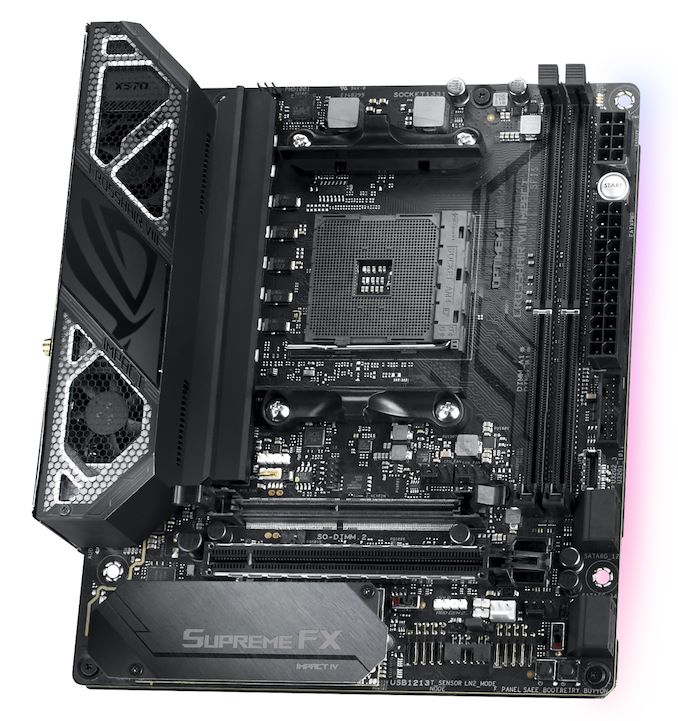The AMD X570 Motherboard Overview: Over 35+ Motherboards Analyzed
by Gavin Bonshor on July 9, 2019 8:00 AM ESTASUS ROG Crosshair VIII Impact
One of the biggest surprises during Computex as far as the announcement of the X570 went was the unveiling of the ASUS ROG Crosshair VIII Impact. Based on the uncommon mini-DTX form factor which is similar to mini-ITX, but with a slightly longer frame, allows ASUS to add an extra expansion slot onto the PCB without sacrificing too much on the overall size of the board. The ROG Crosshair VIII Impact is focused on performance but still offers gaming-focused features along with the rest of ROG/Strix X570 branded product stack.
Included on the ASUS ROG Crosshair VIII Impact is a SO-DIMM.2 slot for PCIe 4.0 M.2 drives, with enough space to spare to add a heatsink too. Featured is a full-length PCIe 4.0 x16 slot which is coated with ASUS Steelslot armor reinforcement. Also featured in addition to the dual PCIe 4.0 M.2 slots are four SATA ports. The same case with the memory as the Crosshair VIII Impact has two memory slots with support for up to 64 GB of DDR4 memory. The design itself follows a more subtle ROG theme with an-all black PCB, black heatsinks and a mesh rear panel cover which features three cooling fans to keep the X570 chipset cool within the rear panel cover. There are also multiple RGB LED lighting zones which users can customize via the ROG Aura Sync software.

Apologies about the blurry image, we will update when we receive a better one
The rear panel of the ASUS ROG Crosshair VIII Impact includes five USB 3.1 G2 Type-A, a single USB 3.1 G2 Type-C, and two USB 3.1 G1 Type-A ports. There are two antenna ports for the Intel AX200 Wi-Fi 6 802.11ax wireless interface, while the single Ethernet port is powered by an Intel I211-AT Gigabit NIC. Also featured is a reset CMOS switch, an LED debug, and a BIOS Flashback button. On the networking side is an Intel I122-AT Gigabit powered Ethernet port, and also includes the new Intel AX200 Wi-Fi 6 enabled wireless interface which features support for BT 5 devices. A Realtek SupremeFX S1220 HD 8-channel audio codec offers three 3.5 mm audio jacks and is assisted by an ESS ES9023P HD DAC which is one of the better spec onboard audio setups on the X570 chipset.
ASUS looks to have put a lot of faith in AMD's new Ryzen 3000 series processors by reintroducing a series that held so much weight in the mini-ITX desktop space. The Crosshair VIII Impact isn't likely to be cheap, however, but as it stands, there is no current MSRP at time of writing.











225 Comments
View All Comments
abufrejoval - Tuesday, July 9, 2019 - link
It's amazing how quickly you run out of PCIe lanes, when you don't have switches to multiplex and translate between PCIe revisions and lanes (e.g. PCIe v4 x2 <-> PCIe v2 x8).I find myself using USB 3.x NBase-T NICs and NVMe adapters, simply because they *do* switch.
Bensam123 - Tuesday, July 9, 2019 - link
Maybe a bit more depth on the power delivery page. I have absolutely no idea how to go about parsing what's there. More chokes is better? What denotes a power phase?A5 - Tuesday, July 9, 2019 - link
+1. Some analysis of that information would be helpful.MrSpadge - Tuesday, July 9, 2019 - link
+1bunkle - Wednesday, July 10, 2019 - link
The controller column includes the total number of phases supported split between CPU cores and SoC e.g. (6+1) = 6 CPU phase and 1 SoC phase. More is *usually* better but has diminishing returns regarding tighter and tighter voltage regulation. Some controllers are better than others (can operate at high frequency e.g. 500KHz v 1000KHz, include other features to improve performance) mitigating the need for more phases.Each phase is a buck converter comprised of a low/high side MOSFET (can be integrated in a single package) and choke. Some controllers can support doubling up the PWM signal to driver more MOSFETs. Doublers can also be added as discrete components if not built into the controller.
Current rating of the MOSFET (e.g. Sic639=40A IR3555=60A) indicates the total power deliverable. MOSFETs are not 100% efficient and vary in efficiency. The more current they provide the hotter they get and the less efficient they become, with better MOSFETs producing less heat for a given current. Thus using doubles can improve temperatures and efficiency without the benefits of the tighter voltage tolerance that *real* phases provide.
Hope that’s helpful!
bunkle - Wednesday, July 10, 2019 - link
A lot more detailed explanation: https://en.wikichip.org/wiki/voltage_regulator_mod...bug77 - Tuesday, July 9, 2019 - link
The description for AsRock X570(M) Pro4 says "5 jack + 1 SPDIF". Unfortunately, those boards lack SPDIF and only come with 3 jacks ;)Smell This - Tuesday, July 9, 2019 - link
I'm thinking the *ASRock Thunderbolt AIC* ...https://thunderbolttechnology.net/product/asrock-t...
would cover all your TBT peripheral needs, including optical.
DanNeely - Tuesday, July 9, 2019 - link
Do X570 boards still need an extra chip per USB port to support USB-C reversibility?The additional expense and needed PCB space were cited as among the reasons why earlier generation boards (IIRC both Intel and AMD) almost never had more than 1 C port; but it was never clear to me if that was an inherent implementation penalty for the C port or an artifact of Intel's tech stack being stalled out and AMD outsourcing to ASMedia which built the chipsets on an ancient (55nm) platform.
DigitalFreak - Tuesday, July 9, 2019 - link
Gavin - X370 and X470 only supported PCIe 2.0. The connection between the CPU and chipset was 3.0, but all the ports on the chipset were 2.0.